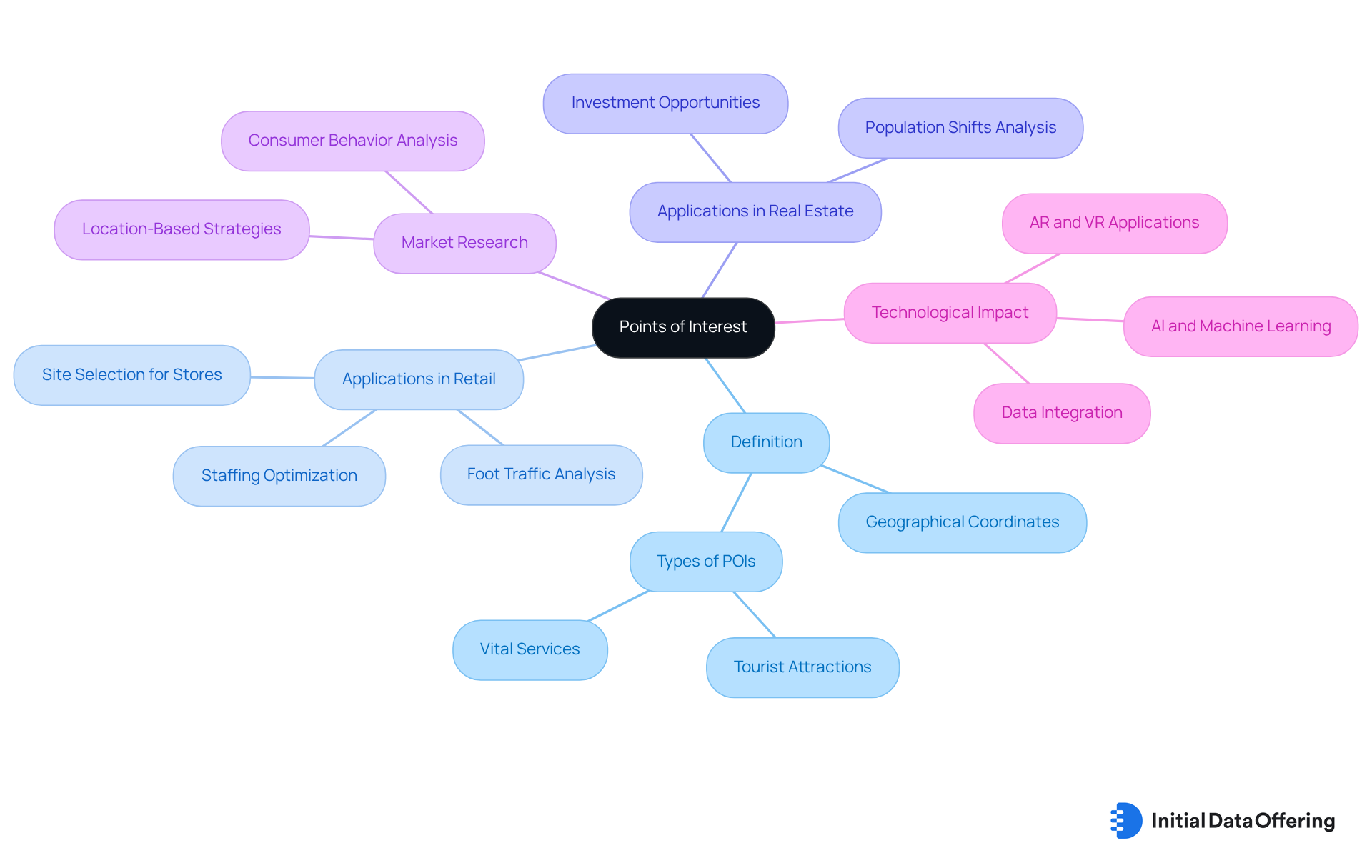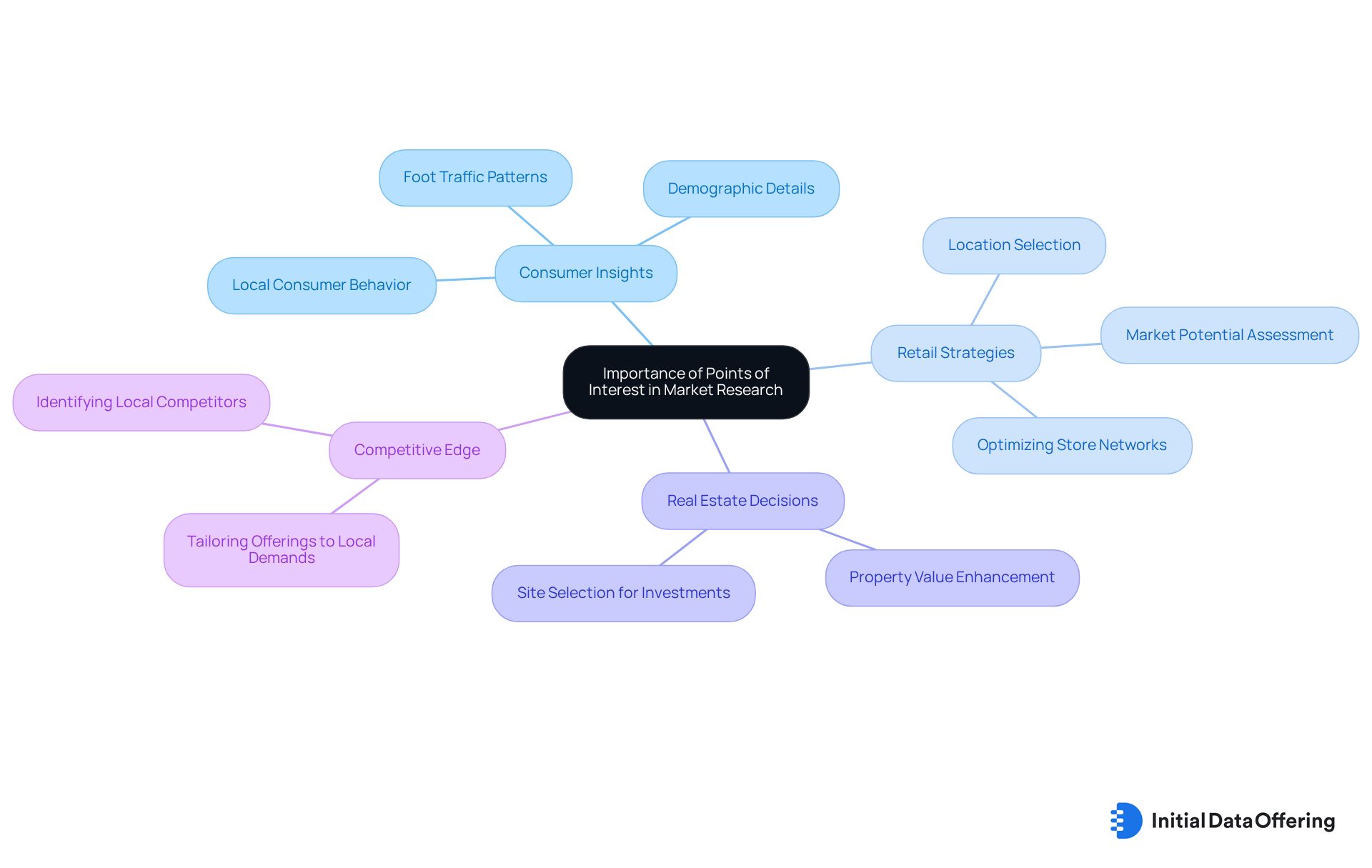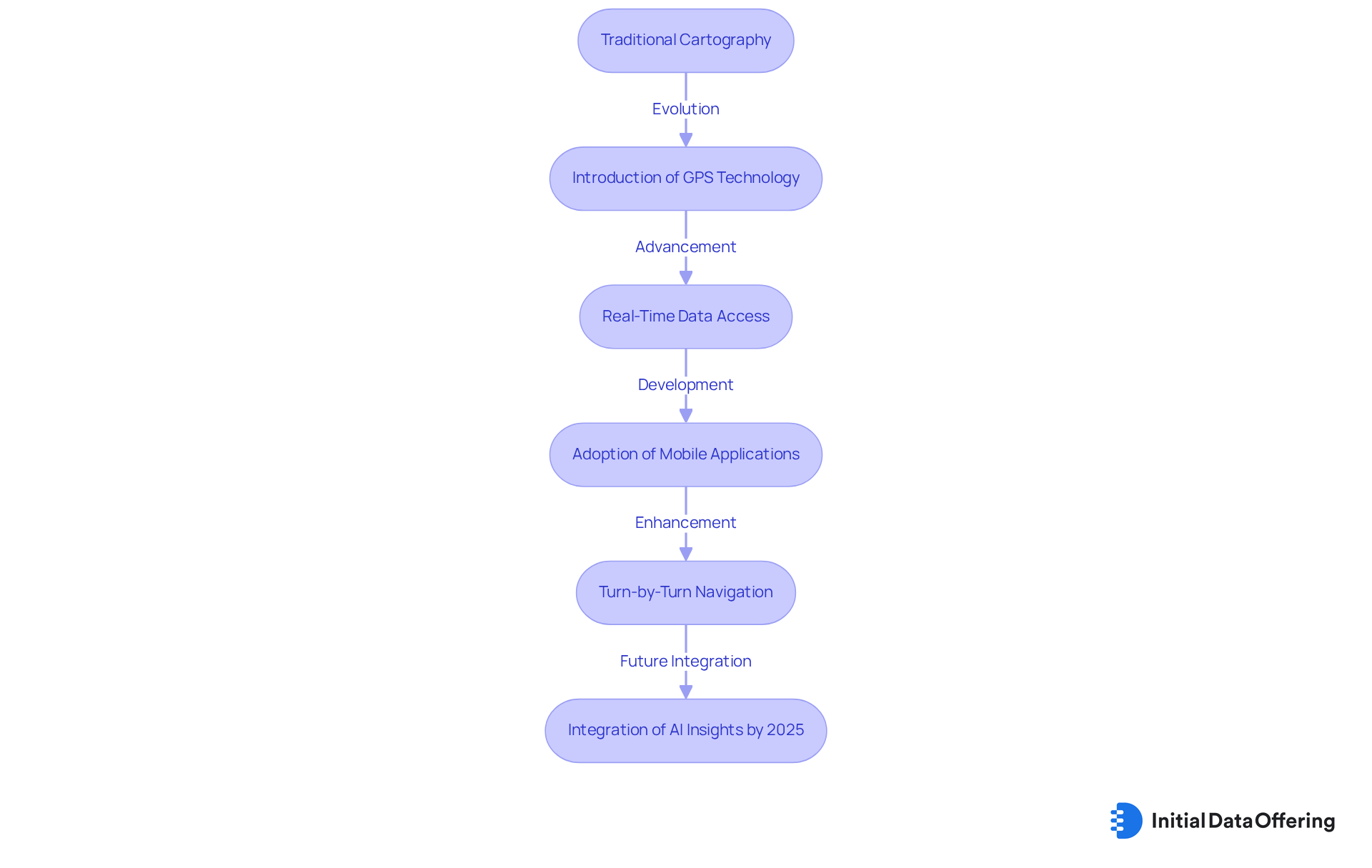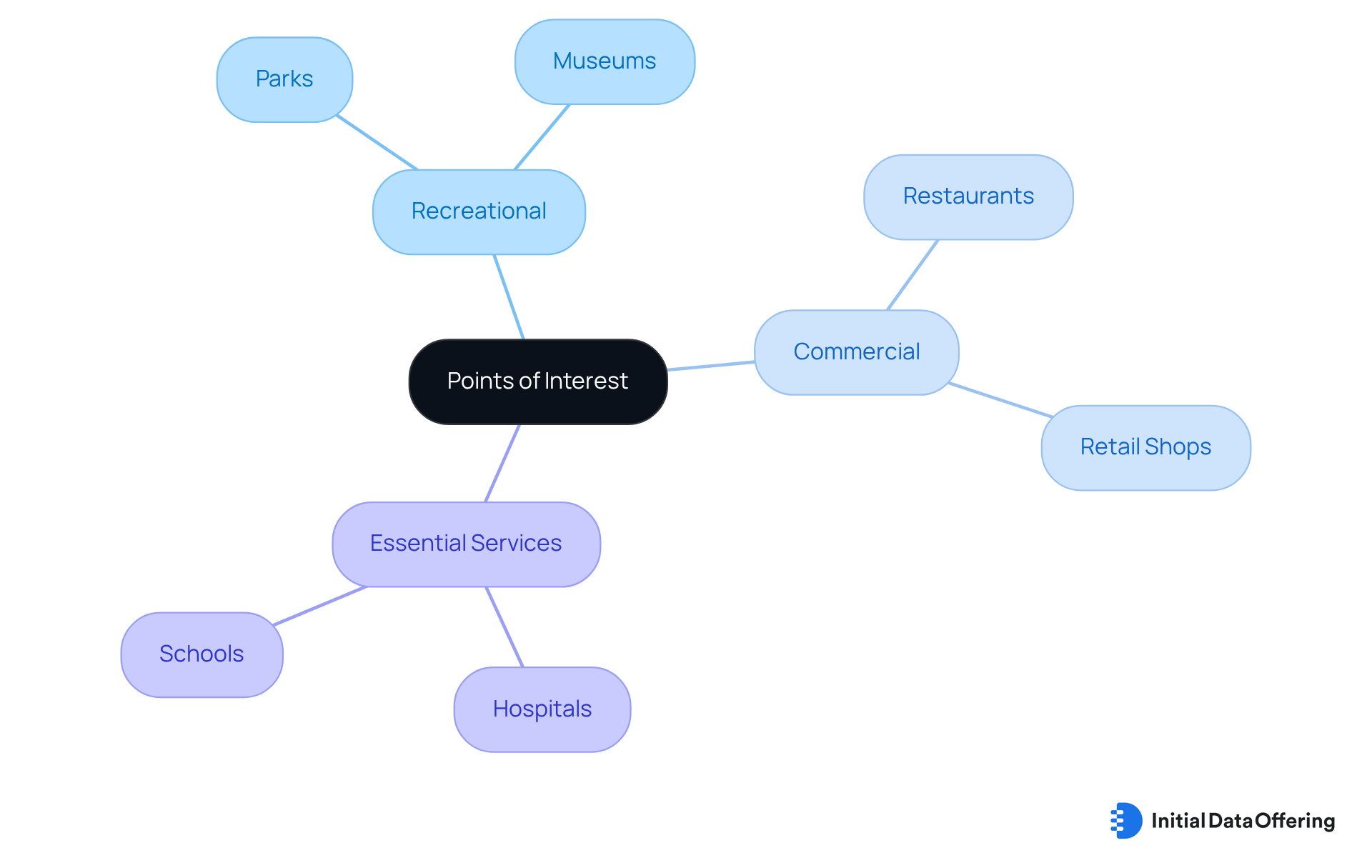Point of Interest: Definition, Importance, and Key Characteristics

Point of Interest: Definition, Importance, and Key Characteristics
Overview
Points of interest (POIs) are defined as significant locations that hold importance for individuals or organizations. These encompass a wide range of sites, from tourist attractions to essential services. POIs are crucial in market research for analyzing consumer behavior and preferences. They are characterized by their geographical coordinates and relevance to user needs. This enables businesses to optimize strategies and enhance operational efficiency by leveraging data on foot traffic and demographic insights.
Understanding POIs allows organizations to tailor their offerings more effectively. By analyzing the data associated with these locations, businesses can identify trends and preferences within their target markets. This insight not only informs marketing strategies but also aids in resource allocation and service delivery.
In conclusion, leveraging data on POIs provides actionable insights that can significantly enhance decision-making processes. As businesses continue to adapt to changing consumer behaviors, the importance of POIs in their strategic planning cannot be overstated. How can your organization utilize this information to improve its market position?
Introduction
Points of interest (POIs) extend beyond mere landmarks on a map; they play a crucial role in understanding consumer behavior and shaping effective business strategies. By analyzing these key locations, organizations can unveil valuable insights that inform a range of initiatives, from marketing tactics to real estate investments. As the landscape of POIs continues to evolve due to advancements in technology and shifting consumer expectations, businesses face the pressing question: how can they effectively harness this data to maintain a competitive edge? This article explores the definition, significance, and defining characteristics of points of interest, highlighting their essential role in market research and strategic decision-making.
Define Points of Interest: Understanding the Concept
A point of interest (POI) signifies a site of importance for individuals or organizations, encompassing everything from tourist attractions like museums and parks to vital services such as hospitals and gas stations. These sites are defined by their , which facilitate straightforward identification on maps and navigation systems. In market research, point of interest serves as a critical indicator, enabling companies to analyze consumer behavior and preferences, thereby guiding location-based strategies.
For instance, retailers can leverage foot traffic analysis at points of interest to optimize staffing levels and identify ideal locations for new stores. This ultimately enhances operational efficiency and marketing effectiveness. Furthermore, commercial real estate investors utilize geographical information to identify investment opportunities by examining regions with increasing foot traffic and population shifts. The significance of point of interest (POIs) extends beyond mere placement; they are vital for understanding market dynamics and consumer interactions.
Experts emphasize that point of interest information is a cornerstone of location intelligence efforts, enabling businesses to uncover emerging trends and make informed decisions. How can your organization harness this data? SavvyIQ's AI-powered APIs enhance this analysis by providing access to a dynamic graph of 265 million global entities, offering deeper insights into point of interest information. As technology evolves, the role of point of interest in market research continues to expand, equipping businesses with the insights necessary to thrive in competitive landscapes.

Contextualize the Importance of Points of Interest in Market Research
Points of interest are essential in market research, offering valuable insights into consumer behavior and preferences. These datasets enable companies to identify strategic locations for new stores, enhance marketing initiatives, and increase customer engagement. For example, retailers can analyze POI data to discern foot traffic patterns and demographic details in specific regions. This understanding allows them to tailor their offerings to effectively meet the points of interest in local demands.
Furthermore, the proximity to attractive points of interest can significantly influence real estate decisions, as closeness to such areas often enhances property value. Thus, comprehending the point of interest is vital for businesses aiming to secure in their respective markets.
How can your organization leverage POI data to improve its strategic decisions?

Trace the Origins and Evolution of Points of Interest
The concept of a point of interest has undergone a significant transformation over the years. Initially rooted in traditional cartography, where specific sites were simply marked on maps, the definition of a point of interest (POI) has expanded dramatically with the advent of GPS technology and digital mapping. Today, a point of interest can encompass a wide variety of locations that meet diverse needs, ranging from restaurants and parks to historical landmarks and service providers.
The integration of GPS technology has revolutionized how individuals interact with their environments. With access to real-time data, mobile applications now provide instant information about nearby amenities and attractions, significantly enhancing user experiences. For instance, the introduction of turn-by-turn navigation in 2009 allowed users to receive voice-guided directions to their chosen point of interest, effectively transforming smartphones into all-encompassing navigation systems and rendering standalone GPS devices nearly obsolete.
Furthermore, advancements in digital mapping have introduced features such as real-time traffic updates and augmented reality overlays, which further enrich the understanding of POIs. By 2025, the anticipated full integration of AI-driven insights into platforms like Google Maps is expected to enhance navigation with customized route suggestions and more intelligent location recommendations. This development will make the points of interest even more accessible and relevant.
Data indicates that the evolution of POIs reflects not only a technological shift but also changing consumer behaviors. As individuals increasingly rely on location-based services, the demand for accurate and dynamic point of interest information has surged. This shift underscores the importance of maintaining to ensure that individuals can make informed decisions based on the most current data available.
Moreover, the launch of the Local Guides program in 2015 has motivated users to contribute reviews and photos, enriching the platform with firsthand insights about businesses and locations, thereby enhancing map accuracy. However, it is crucial to address privacy concerns related to POI information, as it can disclose personal details such as images and movement patterns, necessitating responsible management by businesses.
In conclusion, the evolution of the point of interest, propelled by GPS technology and advancements in digital mapping, highlights the essential role of spatial information in understanding human interactions with their surroundings. As technology continues to advance, the potential for further innovation in POI data collection and application remains vast, promising even greater enhancements in user experience and engagement.

Identify Key Characteristics and Types of Points of Interest
Points of interest are defined by their geographical coordinates, relevance to specific user needs, and the type of information they provide. These features allow for effective categorization into various groups, such as:
- Recreational (e.g., parks, museums)
- Commercial (e.g., restaurants, retail shops)
- Essential services (e.g., hospitals, schools)
Each category serves , catering to different audiences and enhancing user experience. For instance, recreational POIs draw in tourists and locals seeking leisure activities, while commercial POIs play a crucial role for businesses aiming to attract customers. Understanding these characteristics not only aids businesses but also empowers researchers to effectively utilize data related to points of interest in their analyses and strategies.
How can you leverage this information to enhance your own projects or initiatives?

Conclusion
Points of interest (POIs) are integral to both everyday navigation and strategic business decisions. Defined by their significance and geographical coordinates, these locations encompass a diverse range of sites, from recreational venues to essential services. Understanding the multifaceted nature of POIs is crucial for organizations looking to leverage location-based insights to enhance their market strategies and consumer engagement.
Throughout this article, we have highlighted key insights regarding the importance of POIs in market research. The analysis of foot traffic and demographic data enables businesses to make informed decisions about store placements and marketing initiatives. Additionally, the evolution of POIs—driven by advancements in technology and shifts in consumer behavior—underscores the necessity for high-quality, real-time information to meet the demands of a rapidly changing landscape.
The significance of points of interest extends beyond mere identification; it serves as a gateway to understanding consumer behavior and market dynamics. As technology continues to advance, businesses are encouraged to harness POI data to refine their strategies and enhance customer experiences. Embracing the insights offered by POIs empowers organizations to remain competitive and responsive to the needs of their target audiences.
Frequently Asked Questions
What is a point of interest (POI)?
A point of interest (POI) is a site of importance for individuals or organizations, which can include tourist attractions like museums and parks, as well as essential services such as hospitals and gas stations.
How are points of interest defined geographically?
Points of interest are defined by their geographical coordinates, which help in straightforward identification on maps and navigation systems.
Why are points of interest important in market research?
In market research, points of interest serve as critical indicators that allow companies to analyze consumer behavior and preferences, guiding location-based strategies.
How can retailers benefit from analyzing foot traffic at points of interest?
Retailers can leverage foot traffic analysis at points of interest to optimize staffing levels and identify ideal locations for new stores, enhancing operational efficiency and marketing effectiveness.
How do commercial real estate investors use points of interest?
Commercial real estate investors utilize geographical information related to points of interest to identify investment opportunities by examining regions with increasing foot traffic and population shifts.
What role do points of interest play in understanding market dynamics?
Points of interest are vital for understanding market dynamics and consumer interactions, providing insights that help businesses make informed decisions.
How can organizations enhance their analysis of points of interest?
Organizations can enhance their analysis of points of interest by using AI-powered APIs, such as those provided by SavvyIQ, which offer access to a dynamic graph of 265 million global entities for deeper insights.
How is the role of points of interest evolving with technology?
As technology evolves, the role of points of interest in market research continues to expand, equipping businesses with the insights necessary to thrive in competitive landscapes.